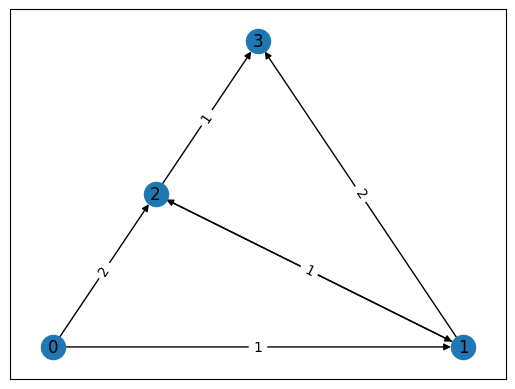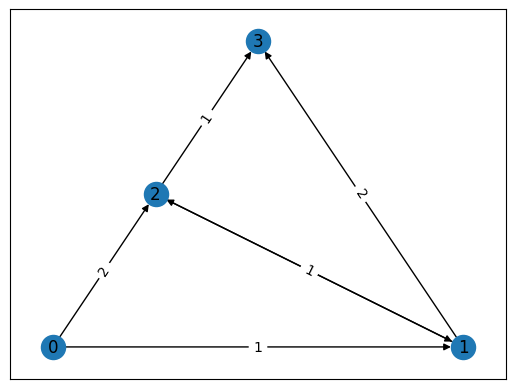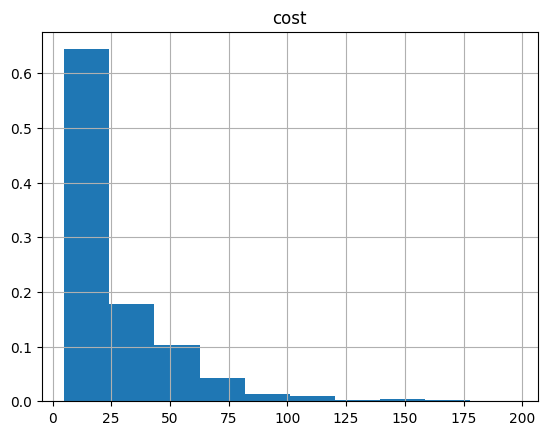Travelling Salesman Problem
Introduction
The "Travelling Salesperson Problem" [1] refers to finding the shortest route between cities, given their relative distances. In a more general sense, given a weighted directed graph, one shall find the shortest route along the graph that goes through all the cities, where the weights correspond to the distance between cities. For example, in the following graph
import networkx as nx # noqa
nonedge = 5
graph = nx.DiGraph()
graph.add_nodes_from([0, 1, 2, 3])
graph.add_edges_from([(0, 1), (1, 2), (2, 1), (2, 3)], weight=1)
graph.add_edges_from([(0, 2), (1, 3)], weight=2)
pos = nx.planar_layout(graph)
nx.draw_networkx(graph, pos=pos)
labels = nx.get_edge_attributes(graph, "weight")
nx.draw_networkx_edge_labels(graph, pos, edge_labels=labels)
distance_matrix = nx.convert_matrix.to_numpy_array(graph, nonedge=nonedge)

one can see that the route which goes along \(0\rightarrow 1\rightarrow 2\rightarrow 3\) yields a total distance 3, which is the shortest.
As many other real world problems, this task may be cast into a combinatorial optimization problem. In this demo, we will show how the Quantum Approximate Optimization Algorithm [2] can be employed on the Classiq platform to solve the Travelling Salesperson Problem.
Mathematical formulation
As a first step, we have to model the problem mathematically. The input is the set of distances between the cities: this is given by a matrix \(w\), whose \((i,j)\) entry refers to the distance between city \(i\) to city \(j\). The output of the model is an optimized route. Any route can be captured by a binary matrix \(x\) which states at each step (row) which city was visited (column): \(\begin{aligned} x_{ij} = \(\begin{cases}1 & \text{at time step } i \text{ the route is in city } j \\ 0 & \text{else}\end{cases}\)\\ \end{aligned}\)
For example: \(\begin{aligned} x=\begin{pmatrix} 0 & 1 & 0 & 0 \\ 0 & 0 & 0 & 1 \\ 0 & 0 & 1 & 0 \\ 1 & 0 & 0 & 0 \end{pmatrix} \end{aligned}\) means that we start from city 1 go to city 3 then to city 2 and end at city 0.
The constrained optimization problem is thus defined as follows:
- find x, that minimizes the path distance - \(\begin{aligned} \min_{x_{i, p} \in \{0, 1\}} \Sigma_{i, j} w_{i, j} \Sigma_p x_{i, p} x_{j, p + 1}\\ \end{aligned}\)
(note that the inner sum over \(p\) is simply an indicator for whether we go from city \(i\) to city \(j\))
such that:
-
each point is visited once - \(\begin{aligned} \forall i, \hspace{0.2cm} \Sigma_p x_{i, p} = 1\\ \end{aligned}\)
-
in each step only a single point is visited - \(\begin{aligned} \forall p, \hspace{0.2cm} \Sigma_i x_{i, p} = 1\\ \end{aligned}\)
Directed graph
In some cases, as in the graph above, not all cities are connected, and it is more proper to describe the problem with a weighted, directed graph. In that case, since we would like to find the shortest path, unconnected cities are assumed to have an infinite distance between them. For example, the graph above corresponds to the matrix
\(\begin{aligned} w=\begin{pmatrix} \infty & 1 & 2 & \infty \\ \infty & \infty & 1 & 2 \\ \infty & 1 & \infty & 1 \\ \infty & \infty & \infty & \infty \end{pmatrix} \end{aligned}\)
In practice we will choose a large enough weight rather than infinity.
Solving with the Classiq platform
We go through the steps of solving the problem with the Classiq platform, using QAOA algorithm. The solution is based on defining a pyomo model for the optimization problem we would like to solve.
Building the Pyomo model from a matrix of distances input
import numpy as np # noqa
import pyomo.core as pyo
## We define a function which gets the matrix of distances and returns a Pyomo model
def PyomoTSP(dis_mat: np.ndarray) -> pyo.ConcreteModel:
model = pyo.ConcreteModel("TSP")
assert dis_mat.shape[0] == dis_mat.shape[1], "error distance matrix is not square"
NofCities = dis_mat.shape[0] # total number of cities
cities = range(NofCities) # list of cities
# we define our variable, which is the binary matrix x: x[i, j] = 1 indicates that point i is visited at step j
model.x = pyo.Var(cities, cities, domain=pyo.Binary)
# we add constraints
@model.Constraint(cities)
def each_step_visits_one_point_rule(model, ii):
return sum(model.x[ii, jj] for jj in range(NofCities)) == 1
@model.Constraint(cities)
def each_point_visited_once_rule(model, jj):
return sum(model.x[ii, jj] for ii in range(NofCities)) == 1
# we define our Objective function
def is_connected(i1: int, i2: int):
return sum(model.x[i1, kk] * model.x[i2, kk + 1] for kk in cities[:-1])
model.cost = pyo.Objective(
expr=sum(
dis_mat[i1, i2] * is_connected(i1, i2) for i1, i2 in model.x.index_set()
)
)
return model
Generating a specific problem
Let us pick a specific problem: the graph introduced above.
# We generate a graph which defines our problem
import networkx as nx
graph = nx.DiGraph()
graph.add_nodes_from([0, 1, 2, 3])
graph.add_edges_from([(0, 1), (1, 2), (2, 1), (2, 3)], weight=1)
graph.add_edges_from([(0, 2), (1, 3)], weight=2)
pos = nx.planar_layout(graph)
nx.draw_networkx(graph, pos=pos)
labels = nx.get_edge_attributes(graph, "weight")
nx.draw_networkx_edge_labels(graph, pos, edge_labels=labels);

We convert the graph object into a matrix of distances and then generate a pyomo model for this example
nonedge = 5 # this variable refers to how much we penalize for unconnected points
distance_matrix = nx.convert_matrix.to_numpy_array(graph, nonedge=nonedge)
tsp_model = PyomoTSP(distance_matrix)
Setting Up the Classiq Problem Instance
In order to solve the Pyomo model defined above, we use the Classiq combinatorial optimization engine. For the quantum part of the QAOA algorithm (QAOAConfig) - define the number of repetitions (num_layers):
from classiq import *
from classiq.applications.combinatorial_optimization import OptimizerConfig, QAOAConfig
qaoa_config = QAOAConfig(num_layers=10)
For the classical optimization part of the QAOA algorithm we define the maximum number of classical iterations (max_iteration) and the \(\alpha\)-parameter (alpha_cvar) for running CVaR-QAOA, an improved variation of the QAOA algorithm [3]:
optimizer_config = OptimizerConfig(max_iteration=50, alpha_cvar=0.4)
Lastly, we load the model, based on the problem and algorithm parameters, which we can use to solve the problem:
qmod = construct_combinatorial_optimization_model(
pyo_model=tsp_model,
qaoa_config=qaoa_config,
optimizer_config=optimizer_config,
)
We also set the quantum backend we want to execute on:
from classiq.execution import ClassiqBackendPreferences
qmod = set_execution_preferences(
qmod, backend_preferences=ClassiqBackendPreferences(backend_name="simulator")
)
write_qmod(qmod, "traveling_saleman_problem")
Synthesizing the QAOA Circuit and Solving the Problem
We can now synthesize and view the QAOA circuit (ansatz) used to solve the optimization problem:
qprog = synthesize(qmod)
show(qprog)
Opening: https://platform.classiq.io/circuit/c7a7f06e-213e-4a50-99d9-d5032079b34b?version=0.41.0.dev39%2B79c8fd0855
We now solve the problem by calling the execute function on the quantum program we have generated:
result = execute(qprog).result_value()
We can check the convergence of the run:
result.convergence_graph

Optimization Results
We can also examine the statistics of the algorithm:
import pandas as pd
from classiq.applications.combinatorial_optimization import (
get_optimization_solution_from_pyo,
)
solution = get_optimization_solution_from_pyo(
tsp_model, vqe_result=result, penalty_energy=qaoa_config.penalty_energy
)
optimization_result = pd.DataFrame.from_records(solution)
optimization_result.sort_values(by="cost", ascending=True).head(5)
| probability | cost | solution | count | |
|---|---|---|---|---|
| 413 | 0.001 | 5.0 | [1, 0, 0, 0, 0, 0, 0, 1, 0, 0, 1, 0, 0, 0, 0, 0] | 1 |
| 38 | 0.003 | 5.0 | [0, 0, 0, 0, 0, 1, 0, 0, 1, 0, 0, 0, 0, 0, 0, 1] | 3 |
| 364 | 0.001 | 5.0 | [0, 0, 0, 0, 0, 0, 0, 1, 0, 0, 1, 0, 1, 0, 0, 0] | 1 |
| 197 | 0.001 | 5.0 | [0, 0, 0, 1, 0, 0, 0, 0, 1, 0, 0, 0, 0, 1, 0, 0] | 1 |
| 43 | 0.003 | 5.0 | [1, 0, 0, 0, 0, 1, 0, 0, 0, 0, 0, 1, 0, 0, 0, 0] | 3 |
And the histogram:
optimization_result.hist("cost", weights=optimization_result["probability"])
array([[<Axes: title={'center': 'cost'}>]], dtype=object)

Lastly, we can compare to the classical solution of the problem:
from pyomo.opt import SolverFactory
solver = SolverFactory("couenne")
solver.solve(tsp_model)
tsp_model.display()
Model TSP
Variables:
x : Size=16, Index=x_index
Key : Lower : Value : Upper : Fixed : Stale : Domain
(0, 0) : 0 : 1.0 : 1 : False : False : Binary
(0, 1) : 0 : 0.0 : 1 : False : False : Binary
(0, 2) : 0 : 0.0 : 1 : False : False : Binary
(0, 3) : 0 : 0.0 : 1 : False : False : Binary
(1, 0) : 0 : 0.0 : 1 : False : False : Binary
(1, 1) : 0 : 1.0 : 1 : False : False : Binary
(1, 2) : 0 : 0.0 : 1 : False : False : Binary
(1, 3) : 0 : 0.0 : 1 : False : False : Binary
(2, 0) : 0 : 0.0 : 1 : False : False : Binary
(2, 1) : 0 : 0.0 : 1 : False : False : Binary
(2, 2) : 0 : 1.0 : 1 : False : False : Binary
(2, 3) : 0 : 0.0 : 1 : False : False : Binary
(3, 0) : 0 : 0.0 : 1 : False : False : Binary
(3, 1) : 0 : 0.0 : 1 : False : False : Binary
(3, 2) : 0 : 0.0 : 1 : False : False : Binary
(3, 3) : 0 : 1.0 : 1 : False : False : Binary
Objectives:
cost : Size=1, Index=None, Active=True
Key : Active : Value
None : True : 3.0
Constraints:
each_step_visits_one_point_rule : Size=4
Key : Lower : Body : Upper
0 : 1.0 : 1.0 : 1.0
1 : 1.0 : 1.0 : 1.0
2 : 1.0 : 1.0 : 1.0
3 : 1.0 : 1.0 : 1.0
each_point_visited_once_rule : Size=4
Key : Lower : Body : Upper
0 : 1.0 : 1.0 : 1.0
1 : 1.0 : 1.0 : 1.0
2 : 1.0 : 1.0 : 1.0
3 : 1.0 : 1.0 : 1.0
If we get the right solution we plot it:
best_classical_solution = np.array(
[int(pyo.value(tsp_model.x[idx])) for idx in np.ndindex(distance_matrix.shape)]
)
best_quantum_solution = np.array(
optimization_result.solution[optimization_result.cost.idxmin()]
)
if (best_classical_solution == best_quantum_solution).all():
routesol = np.zeros(4, dtype=int)
for k in range(4):
routesol[k] = np.where(
best_quantum_solution.reshape(distance_matrix.shape)[k, :] == 1
)[0]
edgesol = list(nx.utils.pairwise(routesol))
nx.draw_networkx(
graph,
pos,
with_labels=True,
edgelist=edgesol,
edge_color="red",
node_size=200,
width=3,
)
nx.draw_networkx(graph, pos=pos)
labels = nx.get_edge_attributes(graph, "weight")
nx.draw_networkx_edge_labels(graph, pos, edge_labels=labels)
print("The route of the traveller is:", routesol)
References
[1]: Travelling Salesperson Problem (Wikipedia)
[2]: Farhi, Edward, Jeffrey Goldstone, and Sam Gutmann. "A quantum approximate optimization algorithm." arXiv preprint arXiv:1411.4028 (2014).
[3]: Barkoutsos, Panagiotis Kl, et al. "Improving variational quantum optimization using CVaR." Quantum 4 (2020): 256.